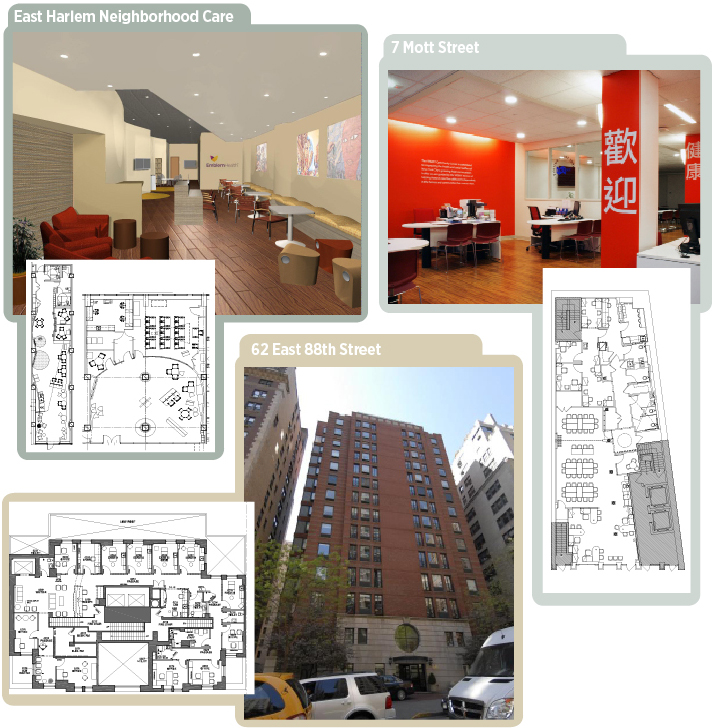
This year is likely to revolutionize the health care industry as 3 million to 4 million previously uninsured Americans have access to medical coverage due to the Affordable Care Act. Between the increasing number of patients, the high prices of real estate and greater demands for efficiency, health care pros are shrinking and altering their work spaces to get patients in and out with ease and speed.
Perhaps the most significant change to affect the real estate industry is the move away from overnight stays in hospitals to shorter-term stays in ambulatory care facilities. Treating patients in these facilities costs less, and with the advent of technology, surgeries that previously had to be done in a hospital can now be done in an ambulatory setting.
Another shift that has been having a huge effect on health care real estate is the absorption of small practices by larger organizations that are multispecialty and multi-location. And then there are the urgicenters, which provide immediate emergency medical help and treatment for a minor illness or injury. While hospitals are trying to get into the urgicenter arena, they “have been late to the game,” said Scott Mason, an executive managing director and leader of the health care practice group in the Americas at Cushman & Wakefield.
Finally, there are now retail establishments like Duane Reade and CVS that are administering medical treatment.
A shift away from a clinical experience to one more akin to shopping has become commonplace at medical facilities.
“At the end of the day, it needs to feel more like a retail type of experience,” said Mr. Mason.
Perkins Eastman is developing an integrative services building in New York City that will allow a patient to be driven up to the front door, grab food on site, plug in a laptop and hang out in a garden. He couldn’t reveal the client.
“We’re building softer clinical environments,” said Jeffrey Brand, a principal and the national health care leader at Perkins Eastman.
So while doctors are looking to conserve money, greater care is being put into office appearance. Doctors now want to have “a clean, contemporary, high-tech space,” said Ciro Fraschilla, president of Mascioni & Behrman, who has been using a more expensive faux wood finish for the floors at many medical practitioners’ offices rather than the traditional carpeting.
Not all has changed in the sector of medical facility real estate. Behind the scenes, there are some logistical elements that always need consideration: power configuration, especially if there are day surgeries being done, height of the ceilings of operating rooms, structural issues because of the weight of imaging equipment and windows in patient rooms, said Timothy Krawetz, the head of the New York health care group for engineering firm Syska Hennessy Group.
Looking ahead, Mr. Mason said New York City can expect to see a model where people would pay by the month for access to a team of medical professionals that would facilitate all medical care. There would be no waiting rooms. After checking in, patients would go directly to their assigned exam room.
As of now, health care is being delivered in more collaborative spaces, with a team treatment-style approach. Currently out of style is the traditional approach of seeing a primary care doctor in one building, a cardiologist in a second building and a pharmacist in a third building. Craig Beam, a managing director at CBRE heading up health care services, said that health care has become more about “treating the population’s wellness.” And often this is being accomplished in one facility.
As hospitals get pressed to limit overnight stays, the ambulatory care business has been booming.
“Definitely, we’ve seen a huge increase in ambulatory care, and Obamacare, or Affordable Care, has a lot to do with it,” said Jeffrey Drucker, who manages the New York City practice of the national health care design firm Array Architects. “We’re starting to see facilities with empty beds or beds being repurposed.” Array’s New York City clients include Montefiore Medical Center, NewYork-Presbyterian Hospital, Mount Sinai Medical Center, North Shore-LIJ Health System and Health & Hospitals Corporation.
He noted that with increased competition, hospitals are now trying to differentiate themselves “by focusing on branding, customer service, design process and flexibility.”
Dan Dolsen, a managing director at CBRE, who does business development for the national health care services group, is actively looking for sites throughout New York City for big health systems to expand with ambulatory care. “And I’d say that pretty much all the major systems are looking at sites,” he said.
Working with less space, architects and developers are forced to come up with more efficient, and multipurpose, office configurations.
Health care spaces, said Paul Wexler of the health care properties team at The Corcoran Group, “need to be designed in as efficient a manner as possible.”
Architects and health care real estate pros Commercial Observer talked to ticked off a number of health care real estate design trends that are taking off.
There is a move away from every physician having an office or consult room and more of a focus on multifunctioning spaces. The examination rooms are being designed so that physicians can do all of their work in them, or they can document notes at a touch-down space outside of the exam rooms. Instead of nurses’ stations, architects are building team centers, which are configured differently than traditional nurses’ stations with more table tops with computers. Waiting rooms are shrinking, and architects are instituting a kiosk check-in system.
Also, more space is being freed up by the requirement that health care providers convert paper medical records to electronic in order to keep their existing Medicaid and Medicare reimbursement levels.
Medical practitioners are being smart when they are building, anticipating growth in their practices down the line.
At 62 East 88th Street, Mascioni & Behrmann is building a 4,400-square-foot office suite for a three-doctor practice, according to Mr. Fraschilla. The plans call for three consultation rooms, five examination rooms and a medical records office space, which will later become an exam room. There will also be two consult rooms that will be subleased to a psychiatrist. Mr. Fraschilla said he is installing plumbing in the walls of the psychiatrist’s offices in case they later are turned into exam rooms.
With the move away from hospital stays, medical practices are providing more comprehensive services.
“A lot of hospitals are building mixed or integrative services,” said Mr. Brand. “It’s a one-stop shop for patients.”
Several people interviewed for this article emphasized how health care real estate today is all about doing more with less.
The square footage required to support a physician has decreased, Mr. Dolsen said, to 1,800 square feet per physician from 2,400.
This is in part because there is a much higher level of standardization, with a focus on efficiency, when doctors become part of group practice. The spaces are less customized around individual doctors.
“We’re building virtual clinics, where independent practitioners can move into a space and it’s basically plug-and-play,” Mr. Beam said.
There are common waiting areas tenants are centralizing laboratory facilities, imaging equipment and file storage spaces.
Before, an individual doctor’s waiting room would usurp 20 percent of a doctor’s space, Mr. Mason said. As part of a larger medical outfit, the doctor could decrease that figure to 5 to 10 percent with a common waiting room, and it could look a lot nicer with an investment from all of the doctors.
“A lot of this,” Mr. Dolsen acknowledged, “is being done for cost reasons.”
With medical space options tight in residential buildings, many small practices are leasing space in commercial buildings.
One developer is repurposing a commercial building downtown as a medical center housing doctors with different specialties.
William Macklowe Company is turning the 250,000-square-foot building at 156 William Street into a medical hub. Approximately 124,000 square feet spread over four floors will be available for lease in June, with the rest available on a rolling basis as tenants’ leases expire.
William “Billy” Macklowe, the founder and chief executive officer of William Macklowe Company, said the building has big floor plates and multiple entrances, the latter of which would allow individual tenants to have their own dedicated entrances.
“I think we’ll see larger group tenancy,” Mr. Macklowe said. “We have 24,000-square-foot floors. They can split to halves or thirds, but I prefer to do a full floor.”
Speaking to the increasingly commercial- and retail-minded philosophy behind medical real estate, Mr. Macklowe said that finding medical practitioners to lease space at 156 William Street requires “think[ing] about tenanting a mall.”




